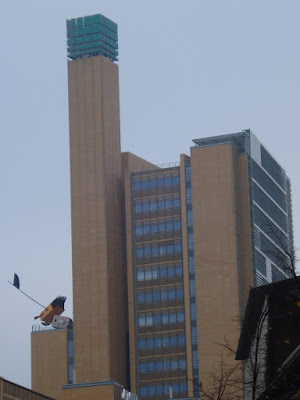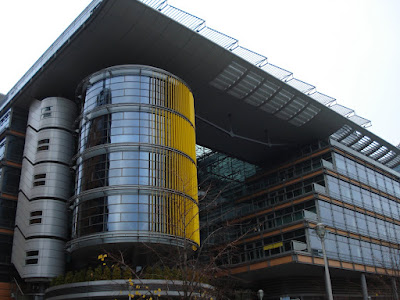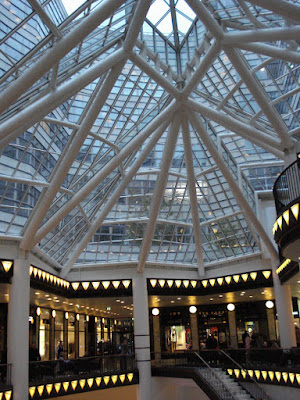In the fall of 1989, I was appointed by a French Bank to create its Representative Office for Turkey and run it. I was, of course, asked to go to Paris to discuss details with Head Office. So I left end - September for Paris where I had two weeks of unending meetings. I was told there that I should also spend a week in a Representative Office to see how things work. And that would be the East Berlin Rep Office, which made me smile, since the German Democratic Republic (GDR) being a communist country, there was only one single bank, nobody was entering through the Rep Office door , and all companies were state-owned, meaning nothing very creative could be done. Exactly like Turkey (!). I found the choice strange, but so what, since I have never been to Berlin. I definitely will find a few moments to visit the Pegamon Museum with the Zeus temple from Bergama I heard so much about , I told myself. My visa was taken, special permissions organised since my plane landed in the West and here I am on Air France, destination Berlin, on Monday November 6th 1989. The Bank's Representative for East Germany (Alex, a Frenchmen from Alsace, thus speaking perfect German) came to pick me up at Tegel Airport and we are driving towards the Eastern part of Berlin. As we approached, the infamous Berlin Wall appeared, filled with graffiti. We stopped at a border gate with stern-looking East German soldiers in their grey uniform checking my papers and I was dropped at my hotel in the famous Unter den Linden avenue in East Berlin .
Seeing the wall I had heard so much about made me think. Why was this wall made ?
Just past midnight, on the night of August 12-13, 1961, while most Berliners were asleep, trucks of East German soldiers and construction workers began tearing up the streets that led into West Berlin, dug holes to put concrete posts, and put barbed wire all across the borders between East and West Berlin. (The concrete wall itself was erected through time. It included guard towers which encircled a large area known as the ''death strip''). Telephone wires between East and West were also cut. When they woke up in the morning, Berliners were shocked. No longer could approximately 60.000 commuters head to West Berlin to work; no longer could friends, families, lovers, cross the border to meet their loved ones; whichever side of the border a Berliner went to sleep on the night of August 12th, he was stuck there for years to come. Furthermore, West Berlin was completely cut off from surrounding East Germany, and East Berlin. It became a capitalist island in communist land.
The wall served to prevent the massive emigration and defection of East Germans to the West. As before the wall's erection, 3.5 million GDR citizens had crossed into West Berlin,never to come back again, the GDR was desperate to stop this mass exodus. After its erection, the wall prevented almost all such emigration since East German guards were ordered to shoot anybody attempting to cross to West Berlin. From 1961 to 1989, 5.000 people tried to escape over the wall, with an estimated death toll of 1.000.
During its life time, the Berlin Wall was called the ''Wall of Shame'' (by German chancellor Willy Brandt) and symbolised the ''Iron Curtain'' that separated Western Europe from the Eastern Bloc during the Cold War.
.
The next two days were spent at work, taking advice from Alex on how to run a Rep Office and talking to Sylvia (his East German secretary). As there was not much activity , I also had plenty of time to visit museums and the city. My conclusion today, after having later on seen what then was West Berlin, is that whatever was nice in Berlin, stayed in the Eastern part of the city after World War II.
On Thursday, November 9th, a glorious, sunny day, something incredible happened. The wall fell down. History was in the making, and here I was watching the ''Wall of Shame'' , the symbolic boundary between capitalism and communism, suddenly go down.
Within hours, hundreds of thousand of Berliners, from both sides of the wall, gathered around it. East Berliners forced their way into the no man's land that had been closed for so many years. West Berliners climbed over the wall to jump on the Eastern side. With no orders on how to handle the situation and at a loss as to what to do, the guards stood back as the checkpoints were overrun by the crowds. In fact, even the East German border guards were watching with amusement and undisguised happiness. Through the entire day and into the night, a great throng of humanity streamed across the border like an unstoppable force. At night, bottles of champagne were being popped and people were deliriously celebrating while taking the wall down with hammers and chisels (the wall was physically destroyed in 1990).
Of course, nobody was going to work and here I am , with Alex, celebrating with the others, watching a bit from the East, crossing to the West and coming back again. A day nobody will ever be able to forget.
There was only one person who did not seem very happy that day and that was Sylvia. When I asked her why, her answer was very interesting : ''Tülin, those people do not realise what is awaiting them after the euphoria has passed. We, East Germans, are not used to work to pay for our doctors or hospitals, for rent, for electricity, telephone, heating or for the schools our children go to. From now on, we will have to. It will not be given free to us as it used to. What are we going to do since what we earn will never be enough to pay for those ?''. In one sentence, she had summarised the problem awaiting all the Ex-Soviet Bloc countries.
 |
| PEOPLE İN LİNE WAİTİNG TO TAKE THE UNDERGROUND TO THE WEST |
 |
| İF YOU MANAGE TO GO İN ! |
 |
| LEFT İS WEST AND RİGHT İS EAST - 1989 |
 |
| EASTERN SİDE, WİTH THE REİCHSTAG (PARLİAMENT) AT THE BACK |
 |
| ONE CHUNK OF THE WALL İS ALREADY DOWN |
 |
| A HOLE İN THE WALL |
 |
| EVERYBODY WANTS TO BE A WİTNESS TO THİS DAY |
 |
| GDR SOLDİERS ON THE WALL |
 |
| EAST GERMAN SOLDİERS AND WEST GERMAN POLİCEMEN İN FRİENDLY DİSCUSSİON |
 |
| NOT EVERYBODY TAKES THE UNDERGROUND - TRAFFİC JAM AT CHECKPOİNT CHARLİE |
I returned to Berlin, now a unified city and the capital of Germany, in 2007. The Eastern part of the city had not changed much, though cleaned up and modernised, but the area where the wall was and the no man's land were unrecognisable. All 20th century architects had designed buildings, some really beautiful, some less so, but all post-modern. The wall had totally disappeared except for a piece kept as souvenir. İn its place was a metal rail-like band that ran on the ground to show where the wall had been. And at crucial points like the Brandenburg Gate or Checkpoint Charlie, there were men dressed as GDR , Soviet and American soldiers for tourists to take pictures with . Human memory is too short. 18 years after its demise, the wall had become a tourist attraction. And those who died trying to be free had been forgotten by the masses.
I believe, the change that took place in Berlin can only be grasped through pictures.
 |
| HERE WAS THE WALL - 2007 |
 |
| THE BERLİN WALL OR WHAT REMAİNS OF İT - 2007 |
 |
| THE GDR REMAİNS İN NAME ONLY- 2007 |
 |
| NEUE WACHE 1989 - MEMORİAL TO THE UNKNOWN SOLDİER THE GDR ARMY HONORİNG İT. |
 |
| NEUE WACHE 2007 - MEMORİAL TO ALL VİCTİMS OF WAR AND DICTATORSHIP |
 |
| THE CLASSİCAL FLAME BURNİNG FOR THE UNKNOWN SOLDİER REPLACED BY A STATUE LOOKİNG LİKE A PİETA. |
 |
| BRANDENBURG GATE 1989 |
 |
| BRANDENBURG GATE, THE WALL WİTH A GDR SOLDİER ON TOP OF İT- 1989 |
 |
| BRANDENBURG GATE - 2007 |
 |
| PARİTZER PLATZ - GDR SOLDİERS AT THE FRONT AND AMERİCAN SOLDİERS BEHİND THE BARRİCADES (10 NOVEMBER 1989). |
 |
| PARİTZER PLATZ - 2007 THE FRENCH, USA EMBASSİES AS WELL AS THE HEAD OFFİCE OF DG BANK HAVE BEEN RE-BUİLT İN THEİR OLD EMPLACEMENT. |
 |
| MEMORİAL TO THOSE WHO LOST THEİR LİVES TRYİNG TO CROSS THE WALL - 1989 |
 |
| SAME MEMORİAL - 2007 |
 |
| THE NAMES OF ALL THOSE WHO DİED ARE WRİTTEN ON THE METAL SHEETS. |
 |
| VİEW FROM THE EAST BERLİN REP OFFİCE WİTH THE REİCHSTAG AT THE BACK - 1989 |

 |
| THE REİCHSTAG AND NEW MİNİSTRY BUİLDİNGS - 2007 |
 |
| THERE WAS A WALL HERE..... |
 |
| THE END-19TH CENTURY REİCHSTAG BUİLDİNG İS STİLL THE SAME FROM OUTSİDE - 1989 AND 2007 |
 |
| IN THE LATEST RE-BUİLDİNG (1995-1999) TO A DESİGN BY SİR NORMAN FOSTER, THE İNTERİOR İS TRANSFORMED İNTO A MODERN MEETİNG HALL CROWNED BY AN ELLİPTİCAL DOME - 2007 |
At about one kilometer south of the Brandenburg Gate and the Reichstag, lies Potsdamer Platz which in the 1920's and 1930's was the busiest and one of the loveliest squares in Europe. As was the case for most of central Berlin, but more due to the address of Hitler's Reich Chancellery just one block away, Potsdamer Platz and all the buildings around it were turned to rubble by air raids and heavy artillery bombing during the last days of World War II. Once the bombing and shelling ceased, and the city was divided into sectors by the occupying Allied Forces, and Postdamer Platz found itself on the boundary between the American, British and Soviet sectors. With the construction of the Berlin Wall, Potsdamer Platz was physically divided into two. The remaining bomb-damaged buildings were cleared, on the Eastern side mainly to give border guards a clear view of escapees and an uninterrupted line of fire. What once was a busy square became completely desolate, nothing but an urban wasteland.
 |
| POTSDAMER PLATZ - 1989 |
In 1991, the Berlin local government opened a tender for urban construction on Potsdamer and nearby Leipziger squares. The design selected came from the Munich architecture office Wilmer & Sattler. The project included the construction of several landmark towers, a shopping arcade, an entertainment center and residential buildings. The whole was developed by various architects and constructed under the supervision of Wilmer and Sattler. And here appeared some of the most post-modern buildings I have seen.
 |
| POTSDAMER PLATZ - 2007 |
 |
| POTSDAMER PLATZ - 2007 |
 |
| DEBİS TOWER DESİGNED BY RENZO PİANO |
 |
| SONY CENTER DESİGNED BY HELMUT JAHN WİTH AN UMBRELLA-LİKE ROOF |
 |
| THE UMBRELLA AT NİGHT |
 |
| MARLENE DİETRİCH PLATZ WİTH THE STELLA MUSİCAL THEATRE DESİGNED BY RENZO PİANO |
 |
| A SCULPTURE BY JEFF KOONS İN FRONT OF THE THEATRE ''BALOON FLOWER'' |
 |
| DAİMLER CHRYSLER BUİLDİNG DESİGNED BY RENZO PİANO |
 |
| RESİDENTİAL AREA |

RESİDENTİAL AREA WİTH ONDULATİNG WALKWAY
 |
| TWO BUİLDİNGS DESİGNED BY RİCHARD ROGERS (WHO DESİGNED THE POMPİDOU CENTER İN PARİS WİTH RENZO PİANO) |
The first one is an addition to a 19th century building on Unter den Linden Avenue, the Deutsches Historisches Museum. The new building has been added by Ming Pei, without ever breaking the relationship with the Baroque one. That must be a feature often used by Ming Pei. Remember the Pyramid of the Louvres in Paris.
Near Checkpoint Charlie, three blocs, named the Friedrichstrasse Passagen, connected by a pedestrian passage underneath, have been erected. The GDR buildings around were demolished in 1992 in favor of the new project. These blocs are in fact shopping malls but you could visit them only for looking at the architecture rather than at the shops. You have shops everywhere, but such architectural design in very few places.
The first mall, called Quartier 207, is a Galleries Lafayette shop, designed by Jean Nouvel. On the outside of the building, you have a full, curved glass facade reflecting its surroundings. Inside, different size glass cones are thrust through the building with the point facing either up or down, sometimes spanning several storeys, sometimes only a few. They look like two glass cones with their bases facing each other. And the reflection of the surrounding stands on the glass creates a bizarre atmosphere. Bravo to Jean Nouvel from me.
The second mall is Quartier 206 enclosing smart boutiques, and designed by Ming Pei. The design reflects the motifs of the Berlin architecture of the 1920's which is interpreted in a totally new way. Bravo to Ming Pei too.
The third mall, Quartier 2005, designed by Oswald Mathias Ungers, did not get a bravo from me. So that explains it all.
But my favorite spot, a building that speaks more than what is holds, was the Jewish Museum, the very first design of a Jewish Polish architect who then became, rightfully in my opinion, famous: Daniel Libeskind.
The building, in the shape of a bolt of lightning, has also been interpreted as a broken Star of David. The windows of the building express tears. The plan, the shape, the zinc-covered exterior are all part of a design used to illustrate the history and culture of the German Jews and the repercussions of the Holocaust. The long, narrow galleries evoke the feeling of loss and dislocation. It is not the exhibition inside that mesmerized me, but the building itself. I had never seen, until that day, a construction that so well expresses the fate of the Jews.
 |
| THE WİNDOWS ON THE ZİNC-COVERED EXTERİOR WALL |
 |
| THE STAİRCASE THAT LEADS TO THE EXHİBİTİON HALLS |
 |
| İN FACT THE STAİRCASE LEADS NOWHERE (YOU TURN LEFT A LİTTLE BEFORE ) |
 |
| AN INSTALLATION THAT REALLY GİVE YOU THE İMPRESSİON PEOPLE ARE BEİNG LED İNTO A GAS CHAMBER |
 |
| AND THOSE PEOPLE ARE SCREAMİNG WİTH FEAR |
 |
| THE WİNDOWS FROM İNSİDE |
 |
| AT THE VERY END OF THE EXHİBİTİON YOU ENTER A VERY DARK ROOM WİTH HİGH WALLS AND THERE İS ONLY NATURAL LİGHT AT THE TOP. A GAS CHAMBER? I FELT A CHİLL. |
Berlin in 1989 and 2007 were two very different cities. The transformation was remarkable. The wall had gone and so had the dark grey and oppressed atmosphere that used to permeate the Eastern part of the city. A new city was born, a place which well-known architects of the 20th century seem to have used as their playground with mixed results. But there was now a new, joyful city, happy of having laid to rest its ghosts.































No comments:
Post a Comment